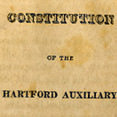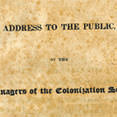Reaction: Document & Activities
View the image:
1802 map of New Haven
.
.
June 22, 1819
In addition to his quarrying and wharfing business, by the late 1810s New Haven’s African-American entrepreneur William Lanson had expanded his business enterprises to include rental property, a large hotel, a grocery store, and a stable and livery service.
“Anti-Slavery in New England” Digital Collection
Special Collections & University Archives, University of Massachusetts, Amherst
http://www.library.umass.edu/spcoll/digital/antislavery.htm
North American Slave Narratives Collection, “Documenting the American South”
University Library, University of North Carolina at Chapel Hill
http://docsouth.unc.edu/neh/
Read the text:
Life of William Grimes
“Anti-Slavery in New England” Digital Collection
Special Collections & University Archives, University of Massachusetts, Amherst http://www.library.umass.edu/spcoll/digital/antislavery.htm
William Lanson’s “Notice” to Columbian Register
Columbian Register (New Haven, CT)
March 14, 1829
In 1811, the Reverend Timothy Dwight, President of Yale College, had praised the work of William Lanson and his brothers as “honourable proof of the character which they sustain, both for capacity, and integrity, in the view of respectable men.”
View the chart:Connecticut Census 1830
United States Historical Census Data Browser, at http://fisher.lib.virginia.edu/collections/stats/histcensus/
Activities
- Digging Deeper: To learn more about the lives of African Americans in Connecticut during the early 19th century, read historian Peter Hinks’s article “The Emergence of Free Black Communities in Connecticut” (download pdf).
- Thinking Like an Historian: Listen to the introductory video segment for this module, “The Attack on Black Citizenship in Connecticut,” with New Haven historian Frank Mitchell. How does the story of William Lanson help us to understand the conditions of African Americans in the early decades of the 19th century? How was Lanson personally affected by the larger political, economic and social transformations occurring around him? Why has William Lanson dropped out of our state and local history?
- Using Primary Documents: Compare and contrast the 1819 Constitution of the Hartford Auxiliary Colonization Society with the 1828 Address to the Public by the Colonization Society of Connecticut (both linked above). How might one account for the changes in the aims and in the general tone of these documents? What clues do these documents provide to better understand the conditions faced by free Blacks like William Lanson and William Grimes?








